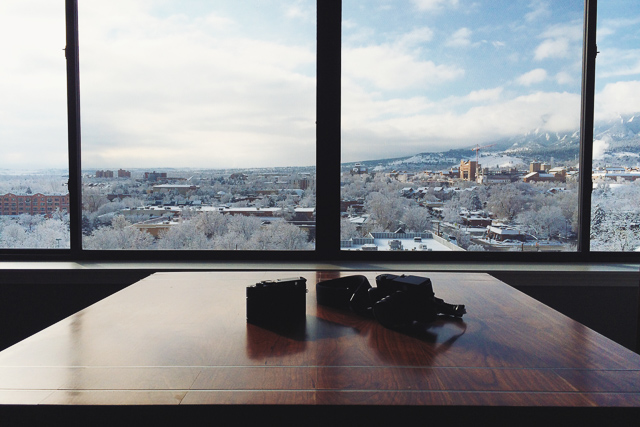
It’s that time of year again—I’m pointing to the tumblr I use to post photos of my every day life. Dailies, I call them. I take a picture of what I see most days and then put it somewhere. So yeah, you can find them at the following confrontational complete sentence dot net: faceit.thisisreal.net. All of my dailies ever should be there unless I made a mistake (of course I did).
My first incarnation of dailies began nearly five years ago. In 2010 I followed some advice, fed off some quality inspiration and started taking a picture of myself every day. It was as difficult as it was vain. I found myself lugging a tripod around everywhere I went and remember feeling uncomfortable (it’s kind of a silly thing to do) in potentially awkward public situations. Giving myself daily, hard deadlines like this stressed me out a good deal but it wasn’t without rewards. That year I probably learned more about the mechanics of photography and composition than in any subsequent year. I even won second place in a photo contest with one of the selfies.
After I finished that project I gave myself a break and then started up again. This time around I relaxed the rules—basically just keep my eye open for things that look neat and try to get one photo per day and if I don’t no big deal but seriously try to get a good one every day.
I was using either my DSLR or my rangefinder to work on the project. I learned even more about composition, logged some serious hours with my Cinch and wore some paint off of that brass block of a seeing machine that I hold in high esteem. I even made 4x6” prints of my 2013 dailies and compiled them into a photo album. That was pretty neat.
I kept up with that incarnation pretty well until about last January. As you may know, workflows dealing with so-called RAW files are not without friction. I found myself falling behind and sometimes uploading photos a month after the fact. According to the rules there was nothing wrong with that, but the friction kept me from spending time on developing other ideas and ambitions—I really want to get into portraits and need to organize my photos into cohesive groups.
In light of all that I changed the rules again. In 2014 I’d do the whole thing on my phone. Not a novel concept, but the idea was that I could take a photo, edit it, upload it and be done in a short amount of time. In practice I ended up editing and uploading the dailies in batches but I did manage to begin work on grouping photos in a cohesive way.
So here we are in 2015. Over these five years my dailies blog has gained 418 followers (compared to 363 following my main tumblr account). I’ve posted about 1503 dailies which amounts to roughly 0.82 photos per day. However, I did take a six month break in 2011. That means that while I was actively trying to do dailies, I didn’t take a photo 0.86% of the time.
I often feel guilty for not getting a photo for the day. The way I framed my “rules,” not getting a photo implied that I didn’t see anything worth capturing or that I didn’t take time that day to enjoy the world around me. Actually crunching the numbers provides some perspective on that guilt: I didn’t live up to the rules < 1% of the time. Given all that’s happened for/to me in the past few years, I’ll take it.
I’ve tried and failed many times to synthesize what taking daily photos means to me. (In fact, I recently realized that jumping wholeheartedly into something without fully understanding why is something I tend to do.) I think at first it really was about learning how to use a camera and to start building up a body of work that I could be proud of. Over time (and as I’ve grown), however, my understanding of the purpose of this project has evolved.
Looking back at these dailies gives me a small taste of the state of my brain on that day in the past. It reminds me about the world as it existed, people that entered my life, people that I pushed away and friends that have always been there. I’ve found that going through old dailies can be an anxiety-inducing experience. But I’ve also found that the entire process helps me to deal with that anxiety in a way that’s healthy for me.
On the front page of my personal website the link that points to my dailies is labeled “i keep a diary.” Late last year a friend of mine saw the link and the dailies and confronted me: “No you don’t,” she said. Needless to say, that made me think. The text posted along with the dailies varies from tautologically descriptive to intentionally obtuse. There’s generally very little indication of how I’m actually feeling, what I’m actually thinking or what actually happened at the time of the photo. I can see how an outsider would find it to be a boring read.
Ignoring the most obvious response (a diary is meaningful to the person who writes it and not necessarily anybody else), that question, in a way, cemented my understanding of the purpose of the whole project.
I’m not on Facebook and I don’t use Twitter for actual status updates, but I want those close to me to be able to check up on me if they want to. I’m concerned about privacy—mine and that of those around me—so I want control over the details associated with each post. I need an outlet to say things I sometimes need to say and a way to remember all the time that’s ruthlessly sucked away from the present. I need a place to practice seeing and make mistakes with minimal consequences.
This project has been all of these things to my multimedia brain.
2014 was an uncomfortable year for me. One thing in particular overshadowed most of the year. I struggled to make sense of relationships and pondered if what lies at the end of the path is what I want it to be. But damn if there weren’t some downright pleasant times as well. There was a wildlife photobomb and there were endearing ocean moments. I rode my bike all over the place and took a couple selfies. I was very often in awe of nature (specifically the sky and clouds). I took my camera with me nearly everywhere and took pictures of things that have changed or disappeared since. I explored and did new things on my own and even talked to my representative about net neutrality.
Thankfully and perhaps most importantly, I woke up every day and kept takin’ those photos.
So if you’re interested, feel free to follow along. Even better, start your own dailies project and let’s notice the beautiful world around us together.


